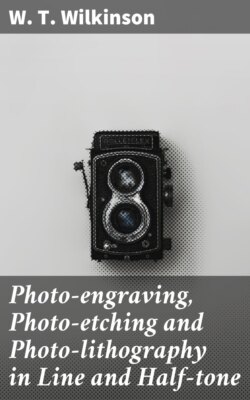Читать книгу Photo-engraving, Photo-etching and Photo-lithography in Line and Half-tone - W. T. Wilkinson - Страница 3
На сайте Литреса книга снята с продажи.
INTRODUCTION.
ОглавлениеTable of Contents
The improvements made within the last twenty years in the art of printing books have not, until recently, been kept pace with by the methods of illustration. Wood engraving, except for high class and expensive editions, was crude, whilst the use of engravings from copper or steel, or of lithographs, was also restricted to short and expensive editions.
The introduction of the zinc-etching process, in which the picture is first drawn in line, or stipple, or chalk, upon lithographic transfer paper, then transferred to a plate of zinc and subjected to a process of etching in various baths of acid water, marks a new era, replete with great improvements in cheapness, facility of production, and artistic results.
This new process had scarcely been in good working order before it was seen that great improvements might be made by enlisting photography in its service; because in its original form it was necessary that the design be made of the same size as the finished block, which, in many cases, added too much to the expense. But by introducing photography, the size of the original was of no moment; the lens could easily reduce that, and at the same time preserve the proportions, as well as fine down any crudity in the drawing.
The first methods of producing a photo-transfer, were by making a negative from the original, then paper coated with bichromated gelatine was exposed under this negative, and the sensitive gelatine, corresponding with the transparent portions of the negative (representing the lines of the original), being exposed to the action of light was made non-absorbent of water, whilst the sensitive gelatine representing the white portion of the original being protected from the action of light by the dark portion of the negative, still retained its affinity for water. The consequence was that when a roller charged with fatty ink was applied to the wet print, the exposed portions of the gelatine took the ink, but the white portion being charged with water rejected it, the result being a replica of the original in a fatty ink. This was used as an ordinary lithographic transfer and could be transferred to zinc and etched in relief. {xvi}
Such a process was not perfect, and was not suitable for subjects which necessarily should be to scale. So the next improvement was to place a plain mirror between the lens and sensitive plate, so producing a negative in its proper position as regards right and left; then from this reversed negative a print in fatty ink could be made direct on the zinc.
These transfers on paper, or direct prints on the zinc, are restricted entirely to what are generally termed “subjects in line,” such as architectural drawings, plans, woodcuts, engravings from steel or copper plates, or lithographs in pure line, in chalk, or in stipple. The attainment of effect of half tones by graduated works of color, thinner or thicker, or the smooth, delicate gradations of a photograph, are not permissible in relief blocks of this kind, although for short numbers this class of subject could be utilized by employing the collotype, heliotype, or lichtdruck methods, which render the half-tones without (visible) breaking up of the gradations.
The next step was to perfect the various (published first in 1854 by Fox Talbot) methods of mechanically breaking up the half-tones of a photograph, and so giving a means whereby a photograph in all its delicacy may be used to illustrate a letter-press article.
Of course, during the progress of rendering photography applicable for relief blocks, its usefulness for intaglio printing was not neglected. And now having entered into very close competition with wood engraving and by modification of the collotype methods, with lithography, photography can now be used for the production of intaglio plates, in half-tones as well as in line.
The methods by which the above results are attained furnish the text of the pages to follow; and as each and every method given has been tried by the author, the reader may be satisfied that the manual is, as claimed, practical.
W. T. WILKINSON.
